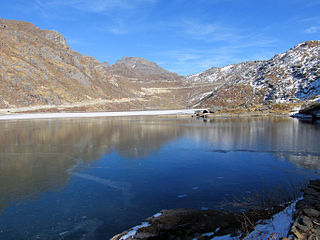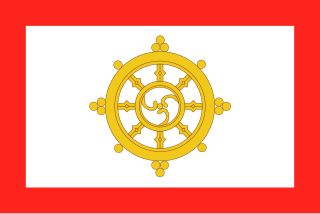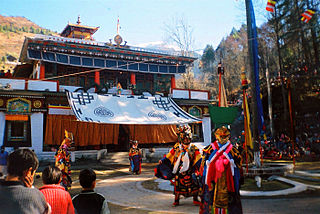Related Research Articles

Sikkim is a state in northeastern India. It borders the Tibet Autonomous Region of China in the north and northeast, Bhutan in the east, Koshi Province of Nepal in the west, and West Bengal in the south. Sikkim is also close to the Siliguri Corridor, which borders Bangladesh. Sikkim is the least populous and second smallest among the Indian states. Situated in the Eastern Himalaya, Sikkim is notable for its biodiversity, including alpine and subtropical climates, as well as being a host to Kangchenjunga, the highest peak in India and third highest on Earth. Sikkim's capital and largest city is Gangtok. Almost 35% of the state is covered by Khangchendzonga National Park – a UNESCO World Heritage Site.

Darjeeling is a town and municipality in the northernmost region of the Indian state of West Bengal. Located in the Eastern Himalayas, it has an average elevation of 2,045 metres (6,709 ft). To the west of Darjeeling lies the easternmost province of Nepal, to the east the Kingdom of Bhutan, to the north the Indian state of Sikkim, and farther north the Tibet Autonomous Region region of China. Bangladesh lies to the south and southeast, and most of the state of West Bengal lies to the south and southwest, connected to the Darjeeling region by a narrow tract. Kangchenjunga, the world's third-highest mountain, rises to the north and is prominently visible on clear days.

The Lepcha are among the indigenous peoples of the Indian state of Sikkim and Nepal, and number around 80,000. Many Lepcha are also found in western and southwestern Bhutan, Tibet, Darjeeling, the Koshi Province of eastern Nepal, and in the hills of West Bengal. The Lepcha people are composed of four main distinct communities: the Renjóngmú of Sikkim; the Dámsángmú of Kalimpong, Kurseong, and Mirik; the ʔilámmú of Ilam District, Nepal; and the Promú of Samtse and Chukha in southwestern Bhutan.

Gangtok District, is an administrative district of the Indian state of Sikkim. It was renamed in 2021 as a result of administrative reorganisation of the state, which also saw three subdivisions of the East Sikkim district spawned off as a separate Pakyong district.

The history of Sikkim begins with the indigenous Lepcha's contact with early Tibetan settlers. Historically, Sikkim was a sovereign Monarchical State in the eastern Himalayas. Later a protectorate of India followed by a merger with India and official recognition as a state of India. Lepchas were the main inhabitants as well as the Ruler of the land up to 1641. Lepchas are generally considered to be the first people, indigenous to Sikkim also includes Darjeeling.

Lepcha language, or Róng language, is a Himalayish language spoken by the Lepcha people native to the Indian states of Sikkim and northern West Bengal, and also neighboring countries of Nepal and Bhutan.

The culture of West Bengal is an Indian culture which has its roots in Bengali literature, music, fine arts, drama and cinema. Different geographic regions of West Bengal have subtle as well as more pronounced variations between each other, with Darjeeling Himalayan hill region and Duars showing particularly different socio-cultural aspects.

The culture of Darjeeling, India, is diverse and has a regional distinctness.

Sikkimese are people who inhabit the Indian state of Sikkim. The dominance ethnic diversity of Sikkim is represented by 'Lho-Mon-Tsong-Tsum' that identifies origin of three races since seventeenth century. The term 'Lho' refers to Bhutias (Lhopo) means south who migrated from Southern Tibet, the term 'Mon' refers to Lepchas (Rong) lived in lower Eastern Himalayas and the term 'Tsong' refers to Limbus, another tribe of Sikkim. The pre-theocratic phase of Sikkim was inhabited by the Kiratis, “Sikkim is also known as the home of the Kirati tribesmen from the pre-historic times.Society in Sikkim is characterized by multiple ethnicity and possesses attributes of a plural society. The present population of Sikkim is composed of different races and ethnic groups, viz., the Lepchas, the Bhutias, the Nepalese and the Plainsmen, who came and settled in different phases of history. The historic 8 May agreement between Chogyal, Government of India and political parties of Sikkim defines Sikkimese as Sikkimese of Bhutia-Lepcha origin or Sikkimese of Nepali origin including Tsongs and Schedule castes. The community in Sikkim is inclusive of three sub-cultural sectors: the Kiratis, the Newaris and the Gorkhas.
Legship is a small town in west district of the Indian State of Sikkim. Legship is the gateway to West Sikkim. It is located on the main road connecting West Sikkim with the rest of the state, on the banks of river Rangit. The place is in fact a main crossing point of roads from Yuksam, Tashiding, Kewzing, Rabangla, Gangtok, Jorethang, Pelling, Gayzing and other places.

Kabi Lungchok is a historic site of significance, which is located 17 kilometres (11 mi) north of Gangtok on the Northern Highway in northeastern Indian state of Sikkim. The historicity of the site is attributed to the fact that the Lepchas, the ethnic tribals of Sikkim and Bhutias, the immigrants from southern Bhot who settled down in Sikkim from the 14th century onwards, ceremonially signed a "Treaty of Blood Brotherhood" with religious fervour. Stone pillars mark the location where the treaty was signed. The Treaty was signed at Kabi Lungchok by the Bhot King, Khye Bumsa representing the Bhutias and the Lepcha Chief Thekong Tek. The literal meaning of 'Kabi Lungchok', pronounced ‘Kayu sha bhi Lungchok’, is "stone erected by our blood." Life-size statues of the Lepcha and Bhutia 'blood-brothers' who signed the treaty has been erected here.
Here is a list of glossary of Culture of India in alphabetical order:
Mun or Munism is the traditional polytheistic, animist, shamanistic and syncretic religion of the Lepcha people. It predates the 7th century Lepcha conversion to Lamaistic Buddhism, and since that time, the Lepcha have practiced it together with Buddhism. Since the arrival of Christian missionaries in the nineteenth century, Mun traditions have been followed alongside that religion as well. The traditional religion permits incorporation of Buddha and Jesus Christ as deities, depending on household beliefs.

The Lho La(Chinese: 洛拉山坳) is a col on the border between Nepal and Tibet north of the Western Cwm, near Mount Everest. It is at the lowest point of the West Ridge of the mountain at a height of 6,006 metres (19,705 ft). It is not exactly a Pass, but a part of Mt. Everest Range
Sonam Tshering Lepcha was an Indian folk musician, composer and lyricist. He was the first among Lepcha people to air his voice on All India Radio and was credited with the revival of Lepcha culture, one of the indigenous cultures of the Indian state of Sikkim. He was reported to be credited with over 400 folk songs, 102 folk dances and 10 dance dramas. He died on 30 July, 2020 due to cardiac arrest.

Tendong Dichhen Salhun Gumpa or Tendong Gumpa as commonly known, is situated atop 8530 ft. altitude from mean sea level (msl). This monastery is surrounded by lush green virgin reserve forest and nearest hamlet is Damthang which is at a six kilometer walking distance. Because of its seclusion, there are no resident monks/nuns in this monastery.

Losoong marks the end of harvest season, of the Bhutia tribe, celebrated every year in December.
Hamro Sikkim Party is a regional political party in the Indian state of Sikkim. The incumbent president of this party is Bhaichung Bhutia. Its election symbol is a Whistle.
Martam–Rumtek Assembly constituency is one of the 32 assembly constituencies of Sikkim a north east state of India. Martam-Rumtek is part of Sikkim Lok Sabha constituency. This Constituency is Scheduled Tribe constituency.

Pokhriabong Lepcha Monastery also popularly known as the " Boudha Terda Pema Lingpa Lepcha Community Gompa " is located in the Indian state of West Bengal approximately 30 km away from the Darjeeling town at a place called Pokhriabong. The monastery follows the teachings and practices of the Nyingma school which is the oldest of the four major schools of Tibetan Buddhism founded by the Vajrayana revealer Guru Padmasambhava. This was the first Buddhist monastery ever built in Pokhriabong.
References
- ↑ "Tendong Lho Rum Faat Festival, Namchi Sikkim India 2019 Dates, Festival Packages & Hotels". Travelwhistle.com. Retrieved 29 July 2019.